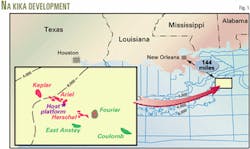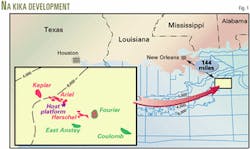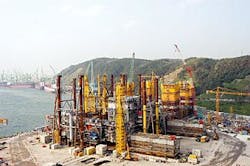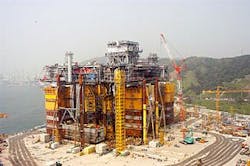Mating the topsides to the hull of the seimsubmersible Na Kika production unit required a superlift on land.
Shell Exploration & Production Co. defines a superlift as a technique for installing a large topsides structure, in one piece, onto a large hull structure with strand jacks rather than cranes. It says Hyundai Heavy Industries Co. Ltd. (HHI) pioneered the technique and, before Na Kika, had used it to install topsides on two deepwater drilling rigs.
The Na Kika superlift took place during the first week of October 2002 in HHI's construction yard in Ulsan, South Korea.
The Shell Exploration & Production Co. and BP PLC $1.26-billion Na Kika project (OGJ, Dec. 9, 2002, p. 9) will develop widely spaced oil and gas fields in the ultradeepwater Mississippi Canyon area of the Gulf of Mexico (Fig. 1). The platform will be moored in Mississippi Canyon Block 474 in about 6,300 ft of water.
Shell expects production to start in mid-2003.
Superlift sequence
For the Na Kika superlift, HHI fabricated the four topsides modules on eight large lifting beams and fabricated the hull on a set of skidways adjacent to the superlift site. It erected four large jacking towers on the interior of the topsides and built eight jacking legs on the exterior (Figs. 2 and 3).
The lift involved a total of 38 strand jacks, each made up of 37 wires, placed at the top of the lifting towers and jacking legs and attached to the lifting beams. Shell says the mating required 7,000 tonnes of steel in the superlift structure to lift the 12,000-tonne topsides.
Shell describes the sequence as follows:
- Raise the topsides about 50 m.
- Skid east and west pontoons under topsides.
- Skid south hull assembly under topsides.
- Skid north hull assembly under topsides.
- Position all hull components to provide best fit of deck legs to hull support stools.
- Weld-out hull components.
- Set topsides down on hull.
Na Kika development
The Na Kika host platform is a permanently-moored, floating development and production system, based on a semisubmersible hull shape,
The oil will be transported to shore via an 18-in. trunkline and gas by the 20-in. Okeanos pipeline (OGJ Online, May 17, 2001).
Initially, the platform will produce through subsea flowlines from 10 subsea wells in five fields with peak production rates expected to reach 425 MMcfd of gas and 110,000 b/d of 25-29° gravity oil. A sixth field will be brought on later when processing capacity allows the production.
Shell estimates the area will recovery more than 300 million boe.
Shell and BP each owns 50% of the Na Kika project. Shell is the predevelopment operator of the development, responsible for the design, fabrication, and installation of the floating host facility and subsea production system, as well as the drilling and completion of the development wells.
BP is the post-production operator, responsible for operating the host facility and surveillance of the satellite subsea fields.
The six fields includes Ariel on MC Block 429, Fourier on MC 522, Herschel on MC 520, and Kepler on MC 383—all of which are owned 50:50 by Shell and BP—East Anstey on MC 607, owned 62.5% by BP and 37.5% by Shell; and Shell's wholly owned Coulomb on MC 657.
Of the fields, which lie in 5,800-7,000 ft of water, Kepler, Ariel, and Herschel are primarily oil fields, and Fourier, East Anstey, and Coulomb are mainly natural gas.
Development drilling began in September 2001 and ended in June 2002 when well completions began. All development wells are satellites tied back with electrically heated and insulated pipe-in-pipe flowlines for oil and uninsulated flowlines for gas. Shell says Coulomb will be tied back to the host facility last, probably in 2005.
The production system includes the following:
- Steel hull, weighing 20,000 short tons and providing 64,000 short tons of displacement.
- Topside facilities, weighing 20,000 short tons.
- Sixteen-leg catenary mooring system consisting of chain, wire rope, and suction piles.
- Complete separation, dehydration, and treatment facilities.
- Quarters module to house up to 60 people and containing a control room and emergency response center.
- Advanced slug control (gas lift, surface slug suppression device, automated process controls, dynamic modeling).
- Dead oil-diesel displacement and operation for flow assurance.
- Coiled tubing gas lift for startup and production enhancement.
- Enhanced produced water treatment to meet best available technology requirements.
- First pipe-in-pipe risers in the world.
- First gas lift risers in the gulf.
- First use of lazy wave risers.
- Largest pipe-in-pipe flowline in the gulf.
- First downhill flow in the gulf.
- First "electrically heated ready" flowlines and risers.
- First deepwater subsea well completion with three commingled reservoirs.
- First deepwater subsea well completions with intelligent well technology.



